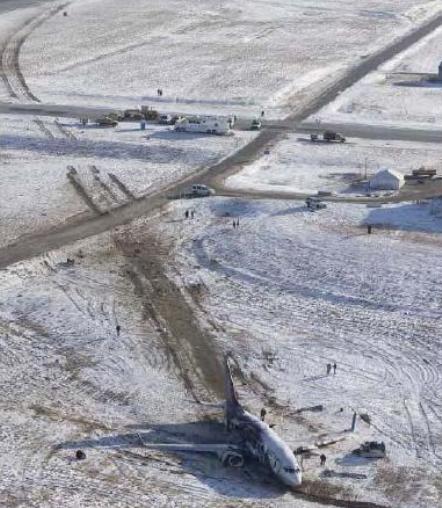The US National Transportation Safety Board (NTSB) has determined that the captain of a Continental Airlines Boeing 737-500 that ran off the left side of Runway 34R at the Denver International airport in clear weather the night of 20 December 2008 did not properly control the aircraft for the extreme, unexpected crosswind conditions during the takeoff run.
According to investigators, Flight 1404 experienced crosswind gusts from the left side of as much as 45kt (83km/h) during the takeoff run, exceeding Boeing's 40kt recommended maximum crosswind component for the aircraft and Continental Airlines' 33kt maximum.
But the pilots were not aware of the intensity of the wind before takeoff. Reported wind by air traffic controllers at the time of the pilots received takeoff clearance indicated a crosswind component of 26kt with no gust factor. Data available to controllers but not typically given to pilots showed winds gusting to higher levels.
 |
|---|
©NTSB |
"This accident started back at the threshold," says NTSB chairman Debbie Hersman. "If [the captain] had had that kind of information he probably would not have initiated the takeoff".
Despite the intensity of the crosswind, investigators determined that probable cause for the excursion and subsequent accident was the captain's "cessation of right rudder" needed to counteract the weathervane effect of the wind and keep the aircraft centred on the runway.
The NTSB says the rudder control would have been adequate to maintain directional control in the winds had the pilot continued to input right rudder pressure after he had made two large corrections for gusts earlier in the takeoff run.
The 737-500 departed the left side of the runway at 119kt speed when the pilot lost directional control, coming to rest in a drainage basin and catching fire. Forty-one of the 115 passengers and crew on board were injured.
The NTSB says pilots will on average experience one takeoff in 15,000 with direct crosswinds (perpendicular to the takeoff direction) as high as 30kt.
"The pilot likely had not seen that high of a crosswind in his experience," the investigators noted.
NTSB also cites as a contributing factor air traffic control's inability to deliver the most relevant wind information available to the pilots, which would have revealed gusts to 36kt.
Also contributing was that Continental's training programme did not include strong and gusting crosswinds in simulator sessions, putting the pilot in a situation where the wind conditions "exceeded his training and experience", says the NTSB.
Investigators say Continental turns off the wind gust effects below 50ft (15m) in its simulators, using only a steady winds at ground level, a factor that eases pilot workload.
Continental, in written input to the NTSB's investigation notes that while the gust model is turned off in the 737-500 simulator below 50ft, it is turned on in the company's four 737-800 simulators at ground level.
"Because all Continental 737 pilots operate all of the 737 models Continental has in line operations, each pilot receives training in all available 737 fleet variant training devices," notes the airline. "Thus, the pilots are exposed to crosswind training in gusty winds during takeoff in the 737-800 FFS and therefore, the 737-500 [full-flight simulator] is not the sole means for crosswind training."
In its 14 recommendations to the FAA, the NTSB asks that surface winds at a variety of airports be used to develop gusty wind profiles that can be used in simulator sessions for airlines, air taxi and fractional operation pilots. In addition, the NTSB is asking that airframers develop type-specific maximum crosswind limits, values which today are recommendations only.
Other recommendations include conducting new research into mountain wave wind phenomena, which was the driving force behind the gusty winds at Denver that night; requiring air traffic controllers to provide pilots with the maximum wind speed information available, including gusts, and requiring the installation of 16g seats for pilots, an upgrade that may have prevented back injuries to both pilots in the Denver accident.
Source: Air Transport Intelligence news



















